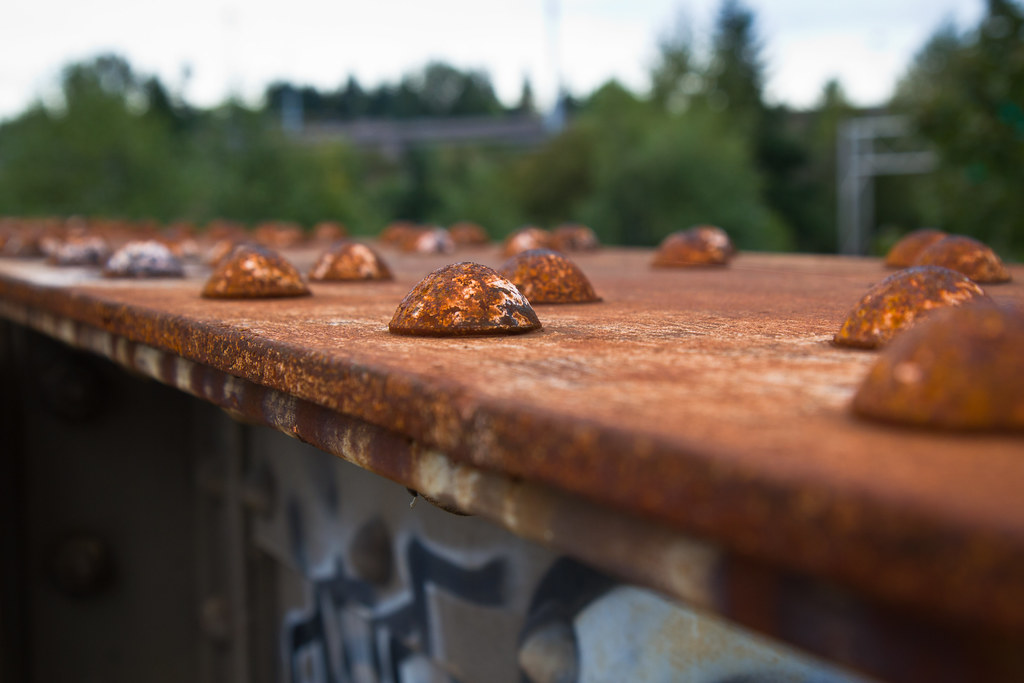At first glance, the Port of Seattle is a hostile, inhuman place. It is a police state on an artificial island, defended by barbed wire and an infinite number of checkpoints and security guards.
It is also a Superfund site, thanks to upstanding corporate citizens such as Shell Oil and their magnificent petroleum storage tanks.
The port’s primary purpose is to transfer an oceanful of containers from enormous cargo ships to endless trains. With over two million containers processed per year, it’s an unimaginably large operation.
The port’s most striking feature are its massive cranes. Were we to encounter them in nature, we would say that like the hummingbird’s tongue, the crane is a fantastic adaptation – in this case, to a natural abundance of standard-sized containers.
Seen at this scale, the port is more Star Wars than Pacific Northwest. In this version the droids took over and dedicated the energies of the universe to replication.
All this hardware is a throwback to an earlier time, before the lures of plastics, when men were men and every American delighted in designing enormous metal machines. When everyone had a hammer, and the the sky burned red from the ore, the smelters, and the sheer joy of manufacturing.
But the cranes are but a means to an end, and that end is containers.
Inside the containers lie dormant the very seeds of the globalized economy. Embodied ideas from every part of the globe, made real by the plastic alchemists of the far East. Protected in their steel shells from wind and water, they float across the Pacific like coconuts on an ironclad tide.
Once unloaded, the mother ship but a memory, all individuality lost, the containers gather in droves on the shores of the promised land. One by one, they are opened and inspected by the paranoia of Seattle’s finest in homeland security. Papers cleared, passports stamped, Geiger counters in silence, the containers await the crab-like vehicles that gather them up in their pincers and deposit them on train lines etched silver on the asphalt docks.
From there onwards, lifelines diverge. Paths fork. Train tracks curve and wind. Cars rust and creak. Steam rises at dawn. In the distance are mountains, shining cities, dust bowls. Transfer stations and miles of highway. Midnight truck stops, fragrance of gasoline and bad coffee. An entire continent awaits.
Eventually, entropy wins. Everything is unloaded. Outside its steel shell, uncertainty entangles and takes dramatic form. Born into the world anew, now remembering only the limbo of the manufacturing floor, countless objects of consumption take flight. Used briefly, most will spend the next millennia underground. A lucky few will find their way back to the gyres of the Pacific, like salmon searching forever for the waters of their birth.
Our creations, like ourselves. Objects whose lives are a brief interlude between eternities of waiting. We are what we make, and we make what we are.
Back at the port, the machines tower over the frail human landscape. Lines are drawn, but priorities are clear.
This is monumental architecture, operating as intended. Bereft of design, formless in the face of function, no frame of reference remains to humanize the grand automation of commerce.
The surrounding highways and bridges offer no respite. They carry streams of motorized containers on wheels, protecting economically precious assets. At sunset, the evening commute melts into the industrial landscape. Until the weekend, we are but cargo.
Alas, there is no such thing as a perpetual motion machine. Left to its own devices, the port will eventually halt. We can prove it. Energy pools will exhaust themselves, iron will rust, and engines will run down. The prime mover is elsewhere, outside the system. It is something more ancient, something native.
Behind every industrial act lie scores of unscratched itches, pools of fermented need, desires never satisfied, multiplication with no divisor. Unspeakably unjust, and yet utterly indistinguishable from legitimacy, from hungry mouths, unshod feet, unclothed limbs.
Naked we emerge from the womb, here to eat, drink and breathe the world, one twenty-foot equivalent unit at a time. A fine line separates our appetites from our combustion engines, our bodies from the machines that do our bidding. Flesh becomes steel and glass, neurons electrons. We increase efficiency, and do more with less.
To gaze at the port is to gaze into the abyss. We may see a monster, but we cannot deny its essential humanity. It is a mirror we hold up to ourselves, a conjoined twin grown to obscene size, sprawled in its own effluence. It is beautiful, and so are we. It is frightening, and so we fear ourselves. More so than humans themselves, the splendid machines are the quintessence of humanity, writ large on the smokestack sky, the polluted water, and the endless freighters.
The complete Flickr set.




















































